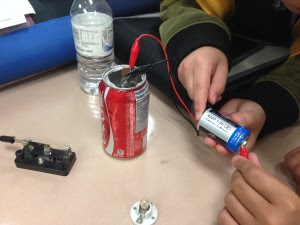By Stephanie Bartlett
Time. We need the slowness of time to really learn and explore a topic and sometimes this is very difficult to honour. I took the time to reflect this summer on some of our projects that best demonstrate my journey as I learn how to slow down and really take the time to figure out what really matters in our classroom. I am beginning to discover that no matter what the program of studies may ask us to teach, it is the topics that invite passion and wonder that allow us to cover curriculum deeply. I share this story as an example of how to take an idea, be it student driven, teacher driven, or both and transform it into a spark that can develop into an in-depth inquiry.
Before Earth Day, there was a cbc.ca challenge inviting bands to perform a song using found objects as instruments. At first,we watched the videos, looking closely at the instruments. Then instruments and objects were left out for exploration.
After a couple of weeks, students chose an instrument and played along, finding the rhythm of the song. The result each time was a heartbreakingly beautiful moment of synchronicity. Students moved to the music, found the beat with their instruments and some sang. Everyone was engaged. No one noticed their teacher willing this moment of learning to suspend us in a calm space amidst a busy morning.
Collaboration moved us forward to the next level when we visited the grade 3/4 classes to see the instruments that they had created. Never underestimate the power and influence of the big kids. Each kindergarten student was paired with an older child who carefully explained their instrument and the process in which they had created an instrument of their choice to reflect changing tone and pitch. In small groups mixed with older and younger students, they worked to compose a rhythm together.
Back in the classroom, we saw a rapid change in the variety of instruments created and increased complexity in the rhythms. We started to create songs in small groups. Some students even ventured to record their music in photo booth. We did not work on this every day, nor did I have a set outcome. My dream goal was a big one: to present their songs at our end of the year celebration. If we didn't get there, I was ok with that because the process of creative development was rich. Formative assessment was ongoing and curriculum was integrated and covered just by the students immersing themselves in the process. Some were more involved than others and that was ok. There are always leaders, innovators and instigators at any age.

The last step was to visit the older buddies one last time to watch their music videos. Students explained the criteria to the kindergarten students...once again the results of collaboration amazed me. We had some very interesting percussion and string instruments and the work of the rock bands began to take shape.
The students presented proudly at our class celebration, showing parents and myself that given time, guidance and patience, an amazing inquiry can keep momentum over a longer period of time, covering more curriculum than one would ever think possible. Jackie Seidel, my professor in Graduate Studies at the University of Calgary, writes in her essay 'A Curriculum for Miracles' that:
a Curriculum for Miracles understands that life can be opened from this
wonderous place called a classroom or school, or it can be closed. Life can
be seen as wonderous or as dull. It can creatively overflow with joy, justice,
peace and love, or it can serve the future, the literal, the non-miraculous...
thus a Curriculum for Miracles is a curriculum that knows life itself as an
Object of Wonder. Fragile. Unique. Interconnected. Just once. (Seidel, 2014)
Echoing Jackie Seidel's thoughts, it is a living curriculum that takes precedence in my program. One of hope, one that allows students to voice and develop their ideas. Giving up my need to control everything that goes on in the classroom and co-developing my program has been instrumental in my shift towards teaching and learning a curriculum that celebrates the joys, the sorrows, and the passions of all stakeholders.
Citation:
Seidel, Jackie (2014). A Curriculum for Miracles. In Jackie Seidel and David W. Jardine (Eds.), Ecological Pedagogy, Buddhist Pedagogy, Hermaneutic Pedagogy: Experiments in a Curriculum for Miracles.





























 Erin Quinn
Erin Quinn








